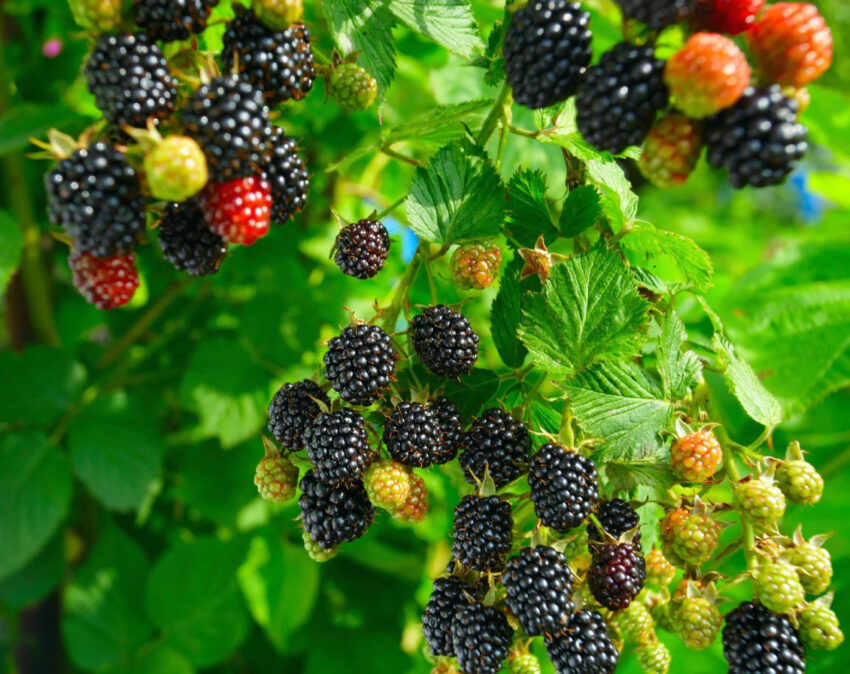
26 Apr How Far Apart to Plant Blackberries: A Comprehensive Guide
Blackberries are a delicious and nutritious fruit that can be grown in your garden or backyard. However, to ensure optimal growth and productivity, you need to know the right spacing for planting them. In this article, we will guide you on how far apart to plant blackberries and everything you need to know about their planting requirements. The content is presented by Newhouseproject.
Introduction
Blackberries are a popular and healthy fruit that is enjoyed by many people. They are easy to grow and can produce a bountiful harvest when cared for correctly. However, before planting blackberries, it’s essential to know how far apart to plant them. The right spacing ensures that the plants have enough room to grow and develop correctly, which ultimately results in healthy, productive plants.
What is the Ideal Spacing for Blackberries?

Image source: Google.com
The ideal spacing for blackberries depends on the variety and whether you are planting them in rows or clusters. However, as a general rule of thumb, blackberries should be spaced between 3 and 6 feet apart in rows and 5 to 6 feet apart in clusters. This spacing allows the plants to have enough room to grow and produce fruit without competing for nutrients, water, and sunlight. Let’s find out: The Essential Tips for Growing and Caring for Indoor Hibiscus Plants
Spacing for Erect Blackberry Varieties
Erect blackberries, also known as primocane-fruiting blackberries, are self-supporting and grow vertically. They should be spaced 3 to 5 feet apart in rows and 5 to 6 feet apart in clusters. This spacing allows them to grow upright and remain self-supporting while still having enough room to produce a bountiful harvest.
Spacing for Trailing Blackberry Varieties
Trailing blackberries, also known as floricanes, are trailing or semi-erect and require support to grow correctly. They should be spaced 5 to 6 feet apart in rows and clusters to allow them to grow in a more sprawling habit and produce abundant fruit.
Factors to Consider When Planting Blackberries
Besides the variety and spacing, several other factors affect how well blackberries grow and produce fruit. These factors include:
Soil Conditions
Blackberries thrive in well-drained, loamy soils with a pH of 5.5 to 6.5. They do not do well in clay or sandy soils and may require amendments to improve soil conditions.
Sunlight
Blackberries require at least six hours of direct sunlight per day to grow and produce fruit. Plant them in a location that receives full sun and is protected from harsh winds.
Watering
Blackberries require regular watering, especially during their growing season. Keep the soil evenly moist but not waterlogged, as excessive moisture can lead to root rot.
Fertilization
Blackberries require regular fertilization to promote healthy growth and fruit production. Apply a balanced fertilizer in the spring before new growth begins and again after fruiting.
Tips for Planting Blackberries
Here are some tips for planting blackberries to ensure their optimal growth and productivity:
- Choose a variety that is suited to your climate and soil conditions.
- Plant blackberries in the early spring when the soil is moist and has warmed up.
- Dig a hole that is twice the size of the root ball and amend the soil with organic matter.
- Plant blackberries at the same depth as they were in their nursery container.
- Water the plants thoroughly after planting and keep the soil evenly moist.
- Mulch around the plants to retain moisture and suppress weeds.
- Provide support for trailing varieties using trellises, stakes, or fences.
Conclusion
Blackberries are a delicious and nutritious fruit that can be grown in your backyard or garden. To ensure their optimal growth and productivity, you need to know how far apart to plant them and the factors that affect their growth. As we discussed, the ideal spacing for blackberries depends on the variety and whether you are planting them in rows or clusters. It’s crucial to consider soil conditions, sunlight, watering, and fertilization when planting blackberries to ensure their optimal growth and productivity.
By following the tips we provided for planting blackberries, you can ensure that your plants have the best chance of producing a bountiful harvest. With proper care and maintenance, your blackberry plants can provide you with fresh and delicious fruit for years to come.


Sorry, the comment form is closed at this time.